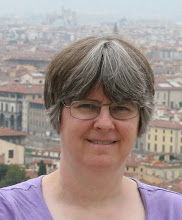The faith of a child
 I witnessed this scene in the Loretto Chapel in Santa Fe (more famous for its miraculous staircase than its statuary). I was struck by the boy's rapt gaze at Jesus, oblivious to the major tourist attraction. "Unless ye become as a little child...." My photos of the staircase were interesting, but nothing like this. Sometimes if you take your eye off what everyone else is looking at, you'll end up capturing the better photograph. It's related to a well known strategy of some photojournalists: rather than pointing the camera at the spectacle, focus on the people watching the spectacle, and you'll get some wonderful shots like this one by famous photojournalist Harry Benson, of Coretta Scott King and her children watching her husband's funeral procession.
I witnessed this scene in the Loretto Chapel in Santa Fe (more famous for its miraculous staircase than its statuary). I was struck by the boy's rapt gaze at Jesus, oblivious to the major tourist attraction. "Unless ye become as a little child...." My photos of the staircase were interesting, but nothing like this. Sometimes if you take your eye off what everyone else is looking at, you'll end up capturing the better photograph. It's related to a well known strategy of some photojournalists: rather than pointing the camera at the spectacle, focus on the people watching the spectacle, and you'll get some wonderful shots like this one by famous photojournalist Harry Benson, of Coretta Scott King and her children watching her husband's funeral procession.
I should point out that I asked the boy's mother for permission to photograph her son. And, in fact, I asked his permission, too. I hadn't been quick enough with my camera when I first saw the scene, and he moved away. But I asked him if he'd go back and stand there gazing at Jesus as he had been before, and he obliged. So it's a staged photo, but it's exactly what it would have looked like if it hadn't been staged. This relates to my post from a couple of days ago on Iambic Admonit about photographing vs. taking photos. While it might have been more natural to take the photo before the boy knew he was being photographed, I'm at least glad that I got to speak to him and his mother about it, and they were pleased to cooperate. I would have felt equally fine about the photo from an ethical standpoint if I'd gotten the permission after I tripped the shutter, and sometimes that's what you've got to do. I'm also not opposed to intentionally (and even mischievously) setting up situations that will result in a great candid photo, such as this one by Harry Benson.















